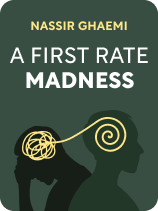

This article is an excerpt from the Shortform book guide to "A First Rate Madness" by Nassir Ghaemi. Shortform has the world's best summaries and analyses of books you should be reading.
Like this article? Sign up for a free trial here.
What’s the connection between mental health and leadership? How does mental illness affect management skills?
Many of us consider good mental health to be an important quality for leaders. However, in A First-Rate Madness, psychiatrist Nassir Ghaemi argues that mental illness can make leaders better fit to lead during a crisis.
Let’s break down why Ghaemi believes good leadership depends on the state of your mental health.
Mental Illness and Leadership
According to Ghaemi, some of the greatest leaders throughout history succeeded not in spite of, but because of their experiences with mental illness. Although conditions such as depression and bipolar disorder can be harmful and exhausting to those who suffer from them, Ghaemi argues that these same disorders can also cultivate powerful management qualities, demonstrating how closely mental health and leadership depend on each other.
(Shortform note: While Ghaemi only reviews a few United States presidents, one study found that out of the first 37 presidents, 49% of them likely suffered from mental illness at some point in their lives. Based on biological records and the Diagnostic and Statistical Manual of Mental Disorders, psychiatrists suggested that 24% suffered from depression and 8% from bipolar disorder. The researchers further concluded that presidential mental illness resulted in no national disasters, which supports Ghaemi’s argument that mental illness isn’t always deleterious when it comes to leadership.)
Defining Mental Health and Mental Illness
We must understand what Ghaemi means by mental health and mental illness to know how they affect leadership.
Mental Health: Ghaemi defines mental health as having no signs of psychological diseases (such as depression) as well as having normal personality traits based on the average population.Mental Illness: According to Ghaemi, someone who’s mentally ill has both the presence of an illness and abnormal personality traits.
Ghaemi argues that, beyond mental illness and wellness, there’s a third category to consider. Some people have abnormal personalities or temperaments, meaning they’re neither ill nor completely healthy. This third category can exist because mental health lies on a spectrum—there’s no definite line dividing mental wellness and mental disorder.
Ghaemi explains that personalities generally form around the age of three and remain relatively unchanged throughout adulthood. People with abnormal personalities have natural traits similar to symptoms of mental illnesses, but those traits are milder and longer-lasting. For example, someone might naturally be more melancholic and have lower energy compared to the average population but not be depressed.
(Shortorm note: By “abnormal personality,” Ghaemi is mainly referring to dysthymia, hyperthymia, and cyclothymia—the first resulting in mild melancholy, the second in mild mania, and the last in mild mood swings. However, other psychologists would categorize these as mood disorders, which distort your emotional state. When talking about “abnormal personalities,” other psychologists may be referring to personality disorders, which are dysfunctional thought and behavior patterns, such as antisocial or schizoid personality disorder. This disagreement over the definition of “abnormal personality” reinforces the idea that mental health exists on a spectrum and that conditions can’t be objectively categorized.)
Unlike for physical diseases, there aren’t any tests that can definitively diagnose mental illness. To make his diagnoses of deceased historical figures, Ghaemi researched for evidence of symptoms, how long the symptoms lasted, family history, and treatment history.
(Shortform note: For each historical figure, Ghaemi is making a retrospective diagnosis—a diagnosis based solely on historical documents. Researchers point out the challenges of making such diagnoses, arguing that a retrospective diagnosis forgoes the typical physician-patient relationship that allows for first-hand observation and is often considered vital to making any type of clinical diagnosis. Furthermore, critics argue that diseases change over time and that documents alone can’t accurately reflect someone’s lived experience. For this reason, they encourage interdisciplinary collaboration between medical specialists and historians for retrospective diagnosis.)
Ideal Mental Health and Two Mental Conditions Affecting Leadership
When it comes to leadership or politics, Ghaemi argues that there’s no such thing as an ideal level of mental health. Rather, the best level of mental health depends on the situation. In peaceful times, good mental health offers many advantages for leadership. However, in turbulent times, mental illness tends not only to produce better leaders, but good mental health can actually produce worse leaders.
(Shortform note: While Ghaemi contends that mental health may not benefit leadership, in general, good mental health benefits quality of life and physical health. Research finds that good mental health gives you a positive outlook, increases your sense of purpose, heightens the intimacy of your relationships, and leads to fewer chronic physical health problems like heart disease and diabetes.)
The reason for this, Ghaemi argues, is that mental illness puts the leader through unique struggles and experiences that enhance traits that are important for navigating sensitive crises. Specifically, leaders during crisis times must have broad perspectives and understand multiple viewpoints and be resilient and innovative in response to unpredictable and unprecedented challenges. Ghaemi identifies two mental illnesses in particular, along with their milder abnormal personality characteristics, that encourage these leadership traits.
(Shortform note: While Ghaemi mentions perspective, empathy, resilience, and innovation as important qualities for people leading in crises, he doesn’t discuss a trait that other experts deem central to crisis leadership: clear communication. During crises, experts assert that a good leader must communicate with their followers openly and honestly to ease anxieties and cultivate trust. Many of the historical leaders that Ghaemi examines, such as Winston Churchill and Martin Luther King Jr., are known for having exceptional communication skills, which may have been unrelated to their mental health struggles.)

———End of Preview———
Like what you just read? Read the rest of the world's best book summary and analysis of Nassir Ghaemi's "A First Rate Madness" at Shortform.
Here's what you'll find in our full A First Rate Madness summary:
- How mental illness can make someone a better leader
- How leaders like Churchill and Roosevelt benefited from mental illness
- The pitfalls of being a mentally well leader during a time of crisis






